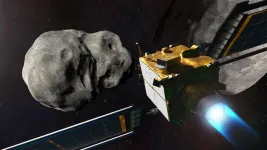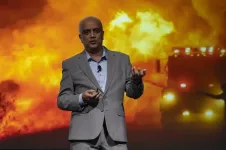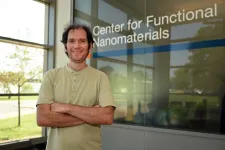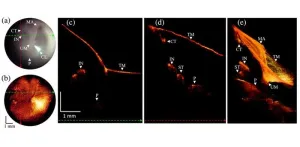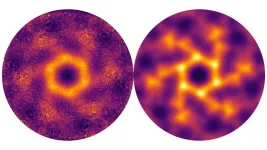(Press-News.org) RIVERSIDE, Calif. -- A multi-institutional team of scientists in the United States, led by physicist Peng Wei at the University of California, Riverside, has developed a new superconductor material that could potentially be used in quantum computing and be a candidate “topological superconductor.”
Topology is the mathematics of shape. A topological superconductor uses a delocalized state of an electron or hole (a hole behaves like an electron with positive charge) to carry quantum information and process data in a robust manner.
The researchers report today in Science Advances that they combined trigonal tellurium with a surface state superconductor generated at the surface of a thin film of gold. Trigonal tellurium is a chiral material, which means it cannot be superimposed on its mirror image, like our left and right hands. Trigonal tellurium is also non-magnetic. Nonetheless, the researchers observed quantum states at the interface that host well-defined spin polarization. The spin polarization allows the excitations to be potentially used for creating a spin quantum bit — or qubit.
“By creating a very clean interface between the chiral material and gold, we developed a two-dimensional interface superconductor,” said Wei, an associate professor of physics and astronomy. “The interface superconductor is unique as it lives in an environment where the energy of the spin is six times more enhanced than those in conventional superconductors.”
The researchers observed that the interface superconductor undergoes a transition under a magnetic field and becomes more robust at high field compared with low field, which suggests a transition into a “triplet superconductor,” which is more stable under a magnetic field.
Furthermore, through collaboration with scientists at the National Institute of Standards and Technology, the researchers showed that such a superconductor involving heterostructure gold and niobium thin films naturally suppresses decoherence sources from material defects such as niobium oxides that are a common challenge for niobium superconductors. They showed that the superconductor can be made into high-quality low-loss microwave resonators with a quality factor reaching 1 million.
The new technology has applications in quantum computing, a field that takes advantage of quantum mechanics to solve complex problems that classical computers or supercomputers can’t solve or can’t solve quickly enough, according to the multinational technology company IBM.
“We achieved this using materials that are one order of magnitude thinner than those typically used in the quantum computing industry,” Wei said. “The low-loss microwave resonators are critical components of quantum computing and could lead to low-loss superconducting qubits. The biggest challenge in quantum computing is to reduce decoherence or quantum information loss in a qubit system.”
Decoherence occurs when a quantum system interacts with its environment, leading to the system’s information getting mixed up with the environment. Decoherence poses a challenge for realizing quantum computers.
Unlike previous methods that require magnetic materials, the researchers’ new approach uses non-magnetic materials for a cleaner interface.
“Our material could be a promising candidate for developing more scalable and reliable quantum computing components,” Wei said.
Wei was joined in the research by his graduate students at UCR.
The title of the paper is “Signatures of a Spin-Active Interface and Locally Enhanced Zeeman Field in a Superconductor-Chiral Material Heterostructure.”
The UCR contribution to the research project was funded by Wei’s NSF CAREER award, a NSF Convergence Accelerator Track-C grant shared by UCR and MIT, and a Lincoln Lab Line fund shared by UCR and MIT.
The technology has been disclosed to the UCR Office of Technology Partnerships and a provisional patent has been filed.
The University of California, Riverside is a doctoral research university, a living laboratory for groundbreaking exploration of issues critical to Inland Southern California, the state and communities around the world. Reflecting California's diverse culture, UCR's enrollment is more than 26,000 students. The campus opened a medical school in 2013 and has reached the heart of the Coachella Valley by way of the UCR Palm Desert Center. The campus has an annual impact of more than $2.7 billion on the U.S. economy. To learn more, visit www.ucr.edu.
END
Unconventional interface superconductor could benefit quantum computing
New material developed by UC Riverside-led team offers promise for developing more scalable and reliable quantum computing components
2024-08-23
ELSE PRESS RELEASES FROM THIS DATE:
NASA’s DART impact permanently changed the shape and orbit of asteroid moon
2024-08-23
When NASA’s Double Asteroid Redirection Test (DART) spacecraft collided with an asteroid moon called Dimorphos in 2022, the moon was significantly deformed—creating a large crater and reshaping it so dramatically that the moon derailed from its original evolutionary progression—according to a new study. The study’s researchers believe that Dimorphos may start to “tumble” chaotically in its attempts to move back into gravitational equilibrium with its parent asteroid named Didymos.
“For ...
Multiple sclerosis appears to protect against Alzheimer’s disease
2024-08-23
People with multiple sclerosis (MS) are far less likely than those without the condition to have the molecular hallmarks of Alzheimer’s disease, according to new research from Washington University School of Medicine in St. Louis.
The discovery suggests a new avenue of research through which to seek Alzheimer’s treatments, said Matthew Brier, MD PhD, an assistant professor of neurology and of radiology and the study’s first author.
“Our findings imply that some component of the biology of multiple sclerosis, ...
DRI’s AWE+ Summit tackles wildfire resilience and recovery
2024-08-23
LAS VEGAS, Nevada — DRI, one of our nation’s leading applied environmental research institutes, together with the DRI Foundation, this week held its inaugural AWE+ Summit -Wildfire Recovery and Resilience: Working Across Silos to Drive Solutions. The summit is a call-to-action for communities to implement measures that support resilience and human adaptability to devastating wildfire events.
Nationally recognized scientific leaders discussed challenges, progress, and hope through actions that will lead to solutions. Speakers included:
President of the National Academy of ...
NIH grant establishes UAB’s Global Research Resource for Human Tuberculosis
2024-08-23
BIRMINGHAM, Ala. – A $5.8 million grant led by Adrie Steyn, Ph.D., of the University of Alabama at Birmingham and the Africa Health Research Institute, or AHRI, in Durban, South Africa, will provide user-requested infected human lung tissue and analytical services to tuberculosis researchers worldwide.
Tuberculosis, or TB, is a bacterial infection that causes 1.3 million deaths and 10.6 million new active cases each year, yet experimental animal models of TB do not reproduce the full spectrum of disease as it occurs in humans. A paucity of human lung tissue ...
Scientists propose guidelines for solar geoengineering research
2024-08-23
Scientists for several years have studied the theoretical effectiveness of injecting sulfur dioxide into the stratosphere to reflect heat from the Sun and offset Earth’s warming temperatures. But they also want to ensure that the solar geoengineering approaches being studied are evaluated for their technical feasibility, as well as their cooling potential and possible ecological and societal side effects.
To guide future work, an international team of scientists led by the U.S. National Science Foundation National Center for Atmospheric Research (NSF NCAR) has published a paper with specific recommendations for evaluating proposals to inject sulfur dioxide, which is known as stratospheric ...
Research spotlight: evaluating hybrid and virtual treatments for children with anxiety and obsessive-compulsive disorder
2024-08-23
Jacqueline Sperling, PhD, a clinical psychologist and assistant professor of Psychology at Harvard Medical School, and co-program director of the McLean Anxiety Mastery Program, led a study investigating the sustainability of outcomes from an intensive group and family-based outpatient cognitive behavioral treatment (CBT) program, that included a hybrid of in-person and virtual treatment sessions for children and adolescents with anxiety disorders and/or obsessive-compulsive disorder (OCD). Her research, which was published last month in Current Developmental Disorders Reports, suggests that an intensive ...
Battelle names Anibal Boscoboinik 'Inventor of the Year'
2024-08-23
Anibal Boscoboinik, a materials scientist at the U.S. Department of Energy’s (DOE) Brookhaven National Laboratory, has been named an “Inventor of the Year” by Battelle Memorial Institute. Battelle, headquartered in Columbus, Ohio, partners with Stony Brook University to form Brookhaven Science Associates, which manages the Lab on behalf of DOE’s Office of Science. Battelle manages or co-manages nine national labs across the country.
At Battelle’s yearly Celebration of Solvers, they award Inventor of the ...
Toward a code-breaking quantum computer
2024-08-23
CAMBRIDGE, MA — The most recent email you sent was likely encrypted using a tried-and-true method that relies on the idea that even the fastest computer would be unable to efficiently break a gigantic number into factors.
Quantum computers, on the other hand, promise to rapidly crack complex cryptographic systems that a classical computer might never be able to unravel. This promise is based on a quantum factoring algorithm proposed in 1994 by Peter Shor, who is now a professor at MIT.
But while researchers have taken great strides in the last 30 years, scientists ...
New imaging device improves ear disease diagnosis
2024-08-23
In the realm of ear health, accurate diagnosis is crucial for effective treatment, especially when dealing with conditions that can lead to hearing loss. Traditionally, otolaryngologists have relied on the otoscope, a device that provides a limited view of the eardrum’s surface. This conventional tool, while useful, has its limitations, particularly when the tympanic membrane (TM) is opaque due to disease.
Enter a groundbreaking advancement from the University of Southern California's Caruso Department of Otolaryngology: a portable OCT otoscope that integrates optical coherence tomography (OCT) with ...
Langbeinites show talents as 3D quantum spin liquids
2024-08-23
A 3D quantum spin liquid has been discovered in the vicinity of a member of the langbeinite family. The material's specific crystalline structure and the resulting magnetic interactions induce an unusual behaviour that can be traced back to an island of liquidity. An international team has made this discovery with experiments at the ISIS neutron source and theoretical modelling on a nickel-langbeinite sample.
When spins in a crystal lattice cannot align to reach a minimum energy together, this is called magnetic frustration. ...
LAST 30 PRESS RELEASES:
New software sheds light on cancer’s hidden genetic networks
UT Health San Antonio awarded $3 million in CPRIT grants to bolster cancer research and prevention efforts in South Texas
Third symposium spotlights global challenge of new contaminants in China’s fight against pollution
From straw to soil harmony: International team reveals how biochar supercharges carbon-smart farming
Myeloma: How AI is redrawing the map of cancer care
Manhattan E. Charurat, Ph.D., MHS invested as the Homer and Martha Gudelsky Distinguished Professor in Medicine at the University of Maryland School of Medicine
Insilico Medicine’s Pharma.AI Q4 Winter Launch Recap: Revolutionizing drug discovery with cutting-edge AI innovations, accelerating the path to pharmaceutical superintelligence
Nanoplastics have diet-dependent impacts on digestive system health
Brain neuron death occurs throughout life and increases with age, a natural human protein drug may halt neuron death in Alzheimer’s disease
SPIE and CLP announce the recipients of the 2025 Advanced Photonics Young Innovator Award
Lessons from the Caldor Fire’s Christmas Valley ‘Miracle’
Ant societies rose by trading individual protection for collective power
Research reveals how ancient viral DNA shapes early embryonic development
A molecular gatekeeper that controls protein synthesis
New ‘cloaking device’ concept to shield sensitive tech from magnetic fields
Researchers show impact of mountain building and climate change on alpine biodiversity
Study models the transition from Neanderthals to modern humans in Europe
University of Phoenix College of Doctoral Studies releases white paper on AI-driven skilling to reduce burnout and restore worker autonomy
AIs fail at the game of visual “telephone”
The levers for a sustainable food system
Potential changes in US homelessness by ending federal support for housing first programs
Vulnerability of large language models to prompt injection when providing medical advice
Researchers develop new system for high-energy-density, long-life, multi-electron transfer bromine-based flow batteries
Ending federal support for housing first programs could increase U.S. homelessness by 5% in one year, new JAMA study finds
New research uncovers molecular ‘safety switch’ shielding cancers from immune attack
Bacteria resisting viral infection can still sink carbon to ocean floor
Younger biological age may increase depression risk in older women during COVID-19
Bharat Innovates 2026 National Basecamp Showcases India’s Most Promising Deep-Tech Ventures
Here’s what determines whether your income level rises or falls
SCIE indexation achievement: Celebrate with Space: Science & Technology
[Press-News.org] Unconventional interface superconductor could benefit quantum computingNew material developed by UC Riverside-led team offers promise for developing more scalable and reliable quantum computing components
